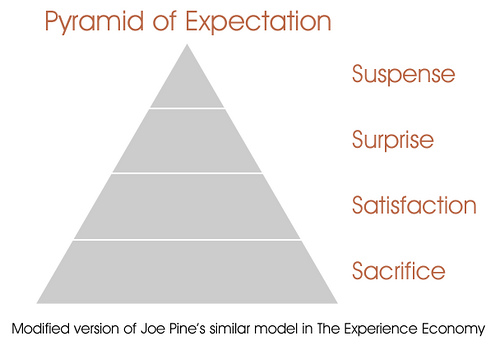
So, I made a bit of a mistake yesterday. I wrote a 3,000 word essay on suspense and brand mystery, rolling in far too many case studies, and providing way more content in one post than I’ve said in past times that one should!
I’m going to, instead, start right at the beginning with a basic overview of expectations. One of the central pillars of a compelling experience is that it exceeds expectations. People are pleased, but not really moved, when their expectations are met. If you don’t meet expectations, then you disappoint people and provide a bad experience. But people are really thrilled and motivated to tell others when they’ve had an experience that exceeded their expectations.
Hence this diagram above that was originally drawn up by Joe Pine and James Gilmore in their seminal book The Experience Economy (affiliate link). BTW, if you any of this stuff on experience interests you at all (and it should, it’s the era we live in) then I’d really recommend you get their book. Ok? Ok. Moving on. Let’s get into what it means.
Scaling the pyramid
Let’s begin in the middle: at the level of customer satisfaction. Most companies today are patting themselves on the back and are thrilled when they hit ’satisfaction’ levels. Now I know that the terminology they are using is not as precise as the terms I’m using here, but still I find this ironic, because satisfaction is quite simply what happens when your exceptions are met.Satisfaction is the fruit of the company delivering on what they promised they would. It’s just like keeping a promise – and in this day and age, keeping a promise shouldn’t be too hard, should it?
Of course, we all know that service and promise keeping is something companies struggle with all day. Hence many customers are left feeling under satisfied. The promise that the company made was not delivered on, which creates customer sacrifice, because they are having to sacrifice on the expectation that the promise set, for the reality of what the delivery is.
A good company will clearly never allow customer sacrifice to take place. They build a relationship of trust with their customers which says that what we say we’ll do, we will do. Not only is customer satisfaction is their standard, but because they are so geared towards delivering great service, the customer often experiences customer surprise. Their expectation as a customer was exceeded, and they were pleasantly surprised.
But what does a great company do that’s different? When your customers are used to being surprised, there comes a new level of experience. It is in fact one of anticipation – the experience of anticipating an experience. This is customer suspense.
This top level is where the big boys live, most noteable of which is Apple, who as I detailed yesterday are masters of suspense (well, almost – there is one lesson they could learn from me.) They have learnt how to manage expectations skilfully – which requires working with a new concept that I’ve been towing with of ‘brand mystery‘.
How does this help me?
Two ways. One, it helps you know where you are, where others are, and how each of them build on the other. Two, knowing what they are, you can now use them to your advantage to manage expectations.
Huh? Manage expections?
Yeah, manage expectations.
And because I’m keen to not overstep the mark and write a long post again, I’ll stop here! But perhaps next week I’ll get into how you begin managing expectations. Again, some of this is in what I wrote yesterday.
So, question time. Where are you on this scale? Come on, let’s get real and be honest. For years I was causing customer sacrifice – I never delivered on the promises that I made. Learning this stuff made me grow up.
That’s me. How about you?
Archived Comments
- banksy6Nice Scott – Interestingly we recently profiled a subsection of our client base to find out where we were and the views were interesting. Areas we felt we excelled in have room for improvement and areas we had almost taken for granted as ‘the way we do business’ showed as being ‘uber’ important to why those clients choose to work with us! All round, we were reaching levels of surprise for many but one things for sure, there is always work to be done and improvements to be made and anyone thinking otherwise should look over their shoulder as the competition will sure as anything be snapping at their heels if they don’t 🙂
- Scott GouldCheers Al for the remarks, it’s good to know that this stuff is happening in your business.
TBH, what I’m saying is nothing new, it’s just a way to describe what already exists and happens continually everyday.
Great that you guys are on the ‘surprise’ level. See today’s post for tips on keeping it up! - Robin DickinsonExcellent remix and reissue of key points, Scott.
I would love to check my customer’s perceptions of 4-S experience when engaging with my consulting business. Have you considered developing some kind of scorecard/questions to enable this? Perhaps I could help you with create it.
Looking forward to the next installment (guess that’s suspense). 😉
Great talking this morning,
Robin 🙂 - Scott GouldIn Experience Economy, Pine and Gilmore go through some of this on a scorecard – but I have my own that I have developed too. I’ll post some up!
Great to talk too, as always. Mulling over how now to re-address my vision for the year 🙂
S - mikemyattHi Scott:
Another great post. I especially liked the point about managing expectations, which is a huge blind spot for many leaders. You might enjoy this post on expectation management: http://bit.ly/7rsaOO
All the best Scott… - Scott GouldThanks Mike, always honoured to have you come by. I’ll read your article and see how it evolves what I’ve done here!
Comments